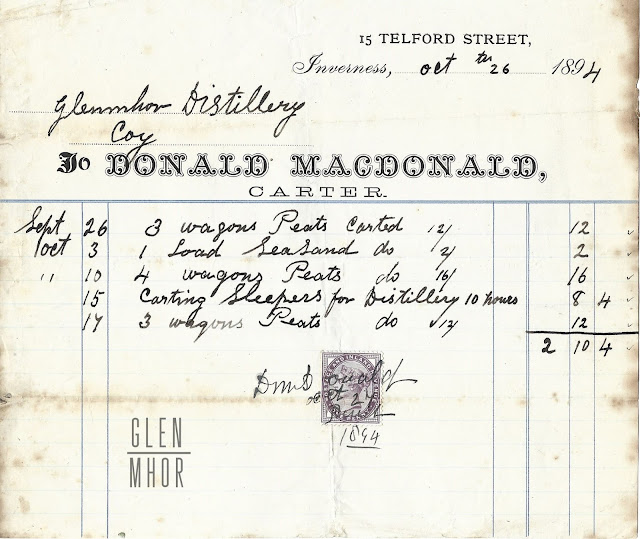Continuing our exploration of the recently acquired collection of Glen Mhor documents, we turn to the distillery's inception in 1894. I extend my gratitude to all who helped spread the word and donated to facilitate the acquisition of these documents, allowing us to expand our online research.
This is an exciting period for all who are engaged with Glen Mhor as the distillery draws ever closer to completion and initiation of production. The recorded date of the inception of Glen Mhor is officially 8th December 1894, as stated in our Timeline. However, we do know that the distillery advertised the availability of draff to farmers in September 1894, which indicates Indicating that the production process, or at least some trial distillations, had begun.
The peat in question would serve as the essential fuel for Glen Mhor distillery's production, providing support throughout its initial full season.
Telford Street was a thriving part of Muirtown, situated ideally between Inverness and the northern gateway. It offered strong transportation links, either by rail, canal or road. And in addition, numerous businesses were located locally. Donald MacDonald of 15 Telford Street, being such an example and engaged in carting goods.
It was convenient for Mackinlay & Birnie to have a nearby business such as this. We are aware from additional documents that this business relationship lasted until at least 1917, as a subsequent invoice is included amongst the collection.
The carters would frequently have delivered shipping goods from beyond Inverness and also those that came up the Caledonian Canal at the Muirtown Basin. It is believed that the railway did not extend entirely into this region in 1894, and the Muirtown siding was only added when the area was utilised as a feature of the US Naval Base during the First World War.

This invoice may show that the first peat arrived at the distillery on 26th September 1894. This was followed by a larger shipment on 10th October and another on 17th October. In total, 10 wagons of peat arrived in just under a month. Our much later invoice from the company suggests that one wagon could carry 4-5 tonnes of freight, with the obvious caveat that in 1894 their equipment may have been more rudimentary.
I asked Michael Billett, author of the excellent
'Peat and Whisky: The Unbreakable Bond', who had recently attended my Glen Mhor tasting in early 2023, for his insight into what this document could tell us. And his comments are fascinating:
'1894 was around the heyday of Eday peat production (but the document doesn’t seem to state that it was Eday peat). The timing (Sept and Oct) of all the documents is also consistent - autumn was the time to secure your annual peat supply and fill that peat shed.'
We know that Glen Mhor certainly used Eday peat and will have the documents to prove it, possibly not as early as 1894. However, given John Birnie's focus on the raw materials needed to make whisky and his high standards, it could be that we see Eday peat being used during his previous management of the
Glen Albyn distillery - something to consider when my research for our nearby neighbour begins in earnest. What's clear is that such decisions about distilling and the materials required would have been made by John as co-owner, rather than the Mackinlays, who were primarily blenders. We also know, and will reveal in a later document, that when the distilleries came under the same ownership, they both used Eday peat.
The other two entries highlight the delivery of railway sleepers, probably for the warehouse floor, and an entry for either 'sea sand' or 'sea land'. It is likely to be the former and sea sand can be used in concrete floors as it has beneficial properties. However, I cannot confirm this at present, but it is something we may be able to answer in future research.
I did reach out to local historians to see if anyone knew more about this carting company. Sadly, It seems the lasting legacy of the firm are these invoices.


Comments
Post a Comment